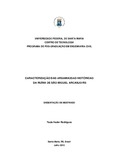| dc.creator | Rodrigues, Paula Nader | |
| dc.date.accessioned | 2014-12-11 | |
| dc.date.available | 2014-12-11 | |
| dc.date.issued | 2013-07-05 | |
| dc.identifier.citation | RODRIGUES, Paula Nader. HISTORICAL MORTARS CHARACTERIZATION FROM SÃO MIGUEL ARCANJO RUIN, RS, BRASIL.. 2013. 142 f. Dissertação (Mestrado em Engenharia Civil) - Universidade Federal de Santa Maria, Santa Maria, 2013. | por |
| dc.identifier.uri | http://repositorio.ufsm.br/handle/1/7853 | |
| dc.description.abstract | Reduction of the Archangel Michael, is one of seven people missionaries who settled
in Rio Grande do Sul, is dated approximately 1687 in the current site. Today the remains of
their remaining part of National Heritage and Declared a World Heritage Site by UNESCO
since 1983.
The great importance of this historic site suggests research in studies on the mortar
coating still exists in parts of the ruin.
Discover the physical and chemical composition is one of the objectives of the
research, which aims to identify the main constituents of the mortar materials, as well as
whether or not the lime and the way it presents itself. In addition, to hypothesize the origin of
the lime used or not of the Misiones region of RS. It also aims to demonstrate the importance
of laboratory tests, such as X-Ray Diffraction, Thermogravimetric Analysis, Scanning
Electron Microscopy (SEM), among others, in research and conservation of monuments.
Through the XRD analysis and ATR-IR was verified using mortar nature calcite as
well as the presence of aragonite in the second set (sacristy) and hydroxyapatite in the first
set (front north). According to the history of the monument there is a probability of calcium
carbonate is, the variation of aragonite, originated from the snail shell snail Physa SP. Kaolin
analysis of this X-ray diffraction (XRD) analysis suggests a contamination of the substrate
because the clay brick was spot. With the images obtained by SEM and EDS, showed the
presence of organic fibers and a binder rich in calcium.
The need for preventive conservation of monuments or buildings of historical interest
makes this work of investigative and scientific nature. The knowledge of the original materials
and the use of compatible materials for restoration is the first step to a good intervention and
not to accelerate the deterioration of historic buildings. | eng |
| dc.format | application/pdf | por |
| dc.language | por | por |
| dc.publisher | Universidade Federal de Santa Maria | por |
| dc.rights | Acesso Aberto | por |
| dc.subject | Argamassa histórica | por |
| dc.subject | Caracterização físico-química | por |
| dc.subject | Preservação | por |
| dc.subject | Historical mortars | eng |
| dc.subject | Physicochemical characterization | eng |
| dc.subject | Preservation | eng |
| dc.title | Caracterização das argamassas históricas da Ruína de São Miguel Arcanjo/RS | por |
| dc.title.alternative | Historical mortars characterization from São Miguel Arcanjo Ruin, RS, Brasil | eng |
| dc.type | Dissertação | por |
| dc.description.resumo | A Redução de São Miguel Arcanjo é um dos sete povos missioneiros que se
instalaram no Rio Grande do Sul, sendo datada de aproximadamente 1687 no atual sítio.
Hoje os vestígios de seus remanescentes, fazem parte do Patrimônio Nacional e Declarados
Patrimônio da Humanidade pela UNESCO desde 1983.
A grande importância deste sítio histórico sugere a pesquisa, em realizar
estudos sobre as argamassas de revestimento ainda existente em partes da ruína.
Descobrir a composição química e física é um dos objetivos da pesquisa, que visa
identificar os principais materiais constituintes da argamassa, bem como a existência ou não
da cal e a forma com que esta se apresenta, além de levantar a hipótese da procedência da
cal utilizada ser ou não da região missioneira do RS. Também visa demonstrar a importância
das análises laboratoriais, como Difração de Raios-X, Análise Termogravimétrica,
Microscopia Eletrônica de Varredura (MEV), entre outras, em trabalhos de investigação e
conservação de monumentos.
Através da análise de DRX e ATR-IR foi possível verificar o uso de argamassa de
natureza calcítica, como também a presença de aragonita no conjunto 2 (sacristia) e
hidroxiapatita no conjunto 1 (fachada Norte). De acordo com o histórico do monumento
existe uma probabilidade do carbonato de cálcio ser, na variação da aragonita, originado da
carapaça de caramujo molusco Physa SP. O caulim presente na análise de difração de raios
X (DRX) sugere uma contaminação do substrato, pois o tijolo era de argila local. Com as
imagens obtidas por MEV e EDS, constatou-se a presença de fibras orgânicas e de um
ligante rico em cálcio.
A necessidade de uma conservação preventiva em monumentos ou em
edificações de interesse histórico torna este trabalho de cunho investigativo e cientifico. O
conhecimento dos materiais originais e o uso de materiais compatíveis para restauro é o
passo inicial para uma boa intervenção e para não acelerar o processo de degradação de
construções históricas. | por |
| dc.contributor.advisor1 | Isaia, Geraldo Cechella | |
| dc.contributor.advisor1Lattes | http://lattes.cnpq.br/8260652949733370 | por |
| dc.contributor.referee1 | Gastaldini, Antonio Luiz Guerra | |
| dc.contributor.referee1Lattes | http://lattes.cnpq.br/9293085240832049 | por |
| dc.contributor.referee2 | Masuero, Angela Borges | |
| dc.contributor.referee2Lattes | http://lattes.cnpq.br/4034282889667153 | por |
| dc.creator.Lattes | http://lattes.cnpq.br/3725844740346270 | por |
| dc.publisher.country | BR | por |
| dc.publisher.department | Engenharia Civil | por |
| dc.publisher.initials | UFSM | por |
| dc.publisher.program | Programa de Pós-Graduação em Engenharia Civil | por |
| dc.subject.cnpq | CNPQ::ENGENHARIAS::ENGENHARIA CIVIL | por |


